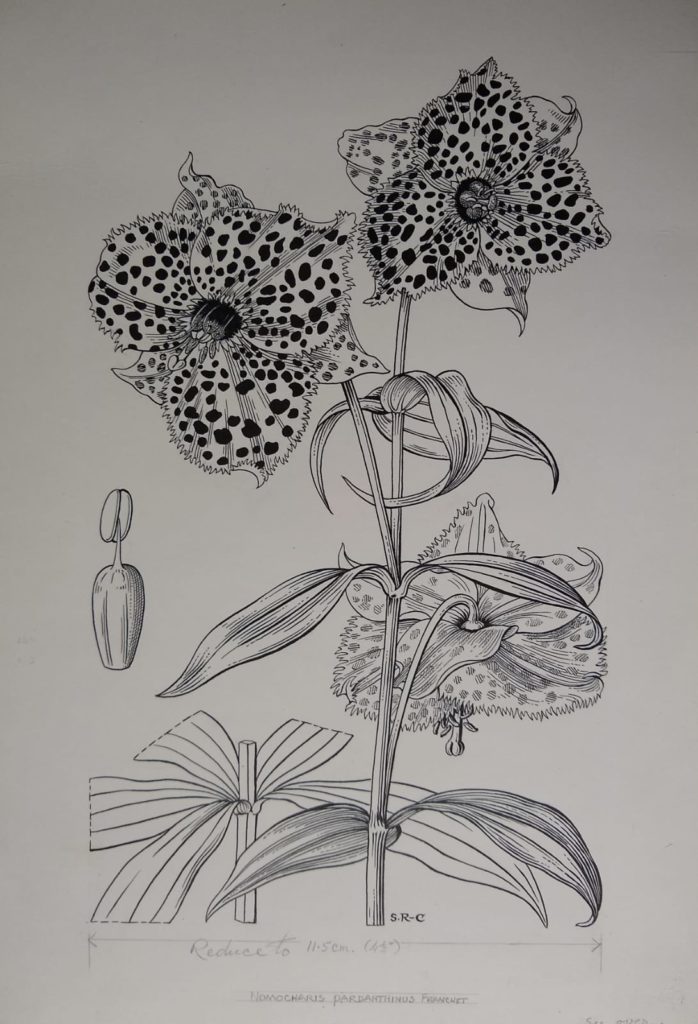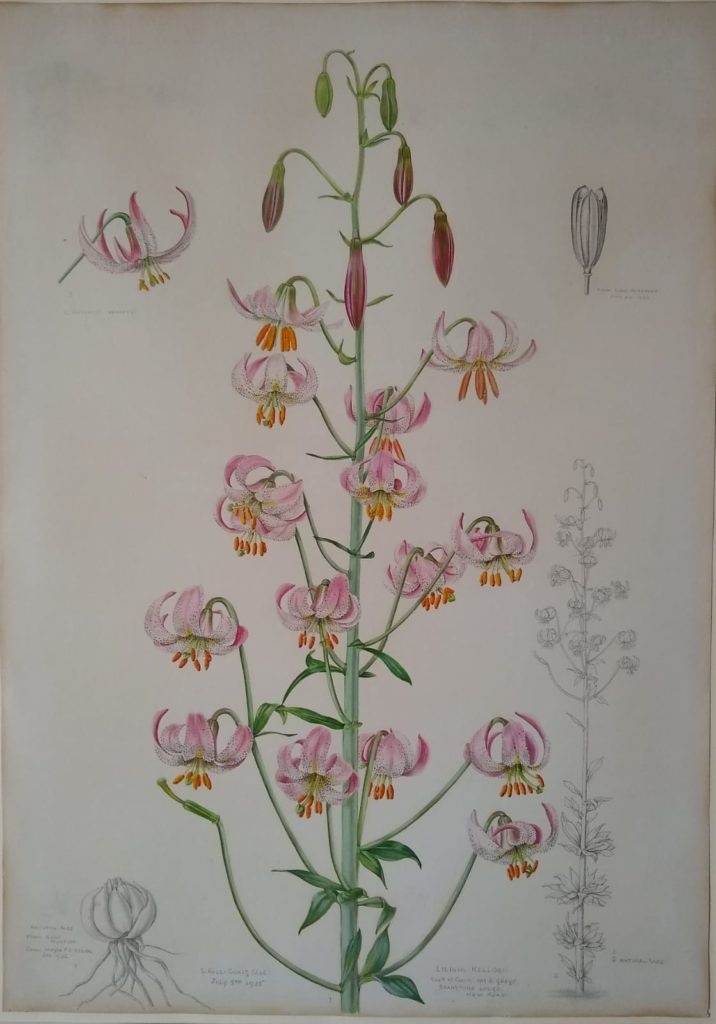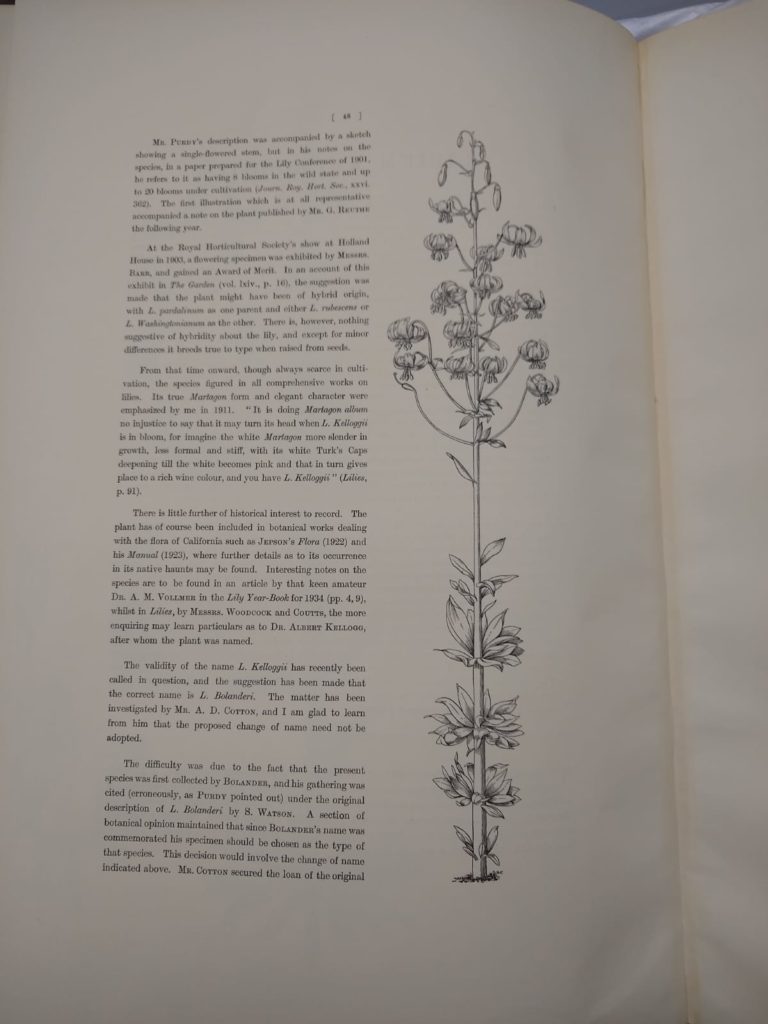Stella Ross-Craig (1906–2006) is best known for her unsurpassed, uncoloured, pen and ink Drawings of British Plants (1948–1973). However, she was also an accomplished painter in watercolour. From 1929 she was based at the Royal Botanic Gardens, Kew, where she made line illustrations for Hooker’s Icones Plantarum and worked on Curtis’s Botanical Magazine for the Royal Horticultural Society. For this, between 1933 and 1955, she produced over 200 colour plates and many drawings of dissections. Some of the watercolours were made in collaboration with Lilian Snelling, who also did the lithography until 1948, when colour printing eventually replaced hand-coloured lithographs. Stella’s painting style was much crisper than Snelling’s and notable for the brilliance and clarity of her colours. It was at Kew that Stella met her husband, the taxonomist J.R. (‘Bob’) Sealy, who specialised in the genus Camellia, but also had historical interests and catalogued the Roxburgh Icones. It was also at Kew, in 1930, that the couple’s friendship with B.L. (‘Bill’) Burtt began, which continued after Bill moved to RBGE in 1951 and lasted until Bob’s death in 2000 and Stella’s, who missed her centenary by a matter of weeks, in 2006.
For the whole of my RBGE career Bill was a major influence and mentor, especially during its taxonomic phase while writing the accounts of monocots for the Flora of Bhutan. Knowing my admiration for Stella’s pen and ink work Bill generously gave me one of her drawings in 1995. He also promised a large watercolour, which has recently come to me following the death of his wife Olive Hilliard.

The drawing was of particular significance as, long familiar from the peat-beds of Scottish gardens, I had then recently been thrilled to see, in the wild in Yunnan, the blotched, pink flowers of Nomocharis pardanthina. But it had other resonances. The drawing was made in July 1977 for a paper on the species by Bob Sealy published in the Notes of the Royal Botanic Garden Edinburgh in a festschrift to mark Bill’s sixty-fifth birthday in 1978; it is, moreover, one of Stella’s last works as by this point (aged 71) she had largely given up drawing. In fact, it was drawn not from life but based on a painting she had made in 1939. In 1983 the drawing was republished in the Botanical Journal of the Linnean Society in a monograph of the genus by Sealy. Bill’s treasured gift was also the means through which I came to know Stella. I wrote to tell her how much I liked the drawing and that I admired her by then rare use of pure line and the avoidance of stipple that has come to plague modern botanical illustration. In her reply she wrote ‘I dislike stipple work … it could be mistaken for tiny glands on leaves, or pits on seeds & so on’.

The watercolour of Lilium kelloggii is a spectacular work of a spectacular plant. Fortunately, in reminiscing old age, Stella wrote an account of how it came about:
A day painting Lilium kelloggii, 3rd July 1935, by Stella Ross-Craig
A very delightful day – first being taken to Branstone Lodge, Kew Road (now demolished), by Mr Cotton (“Bunny”), Keeper of the Herbarium, who, on the way, told me about his recent visit to Paris, which seemed to boil down to too many strawberries to eat when hungry, and only champagne to drink when thirsty!
Arriving at the house I was taken into the garden to see the Lily – not one, but a whole border! – and the one waiting for its portrait to be painted was 7 feet tall! A factotum of the place (Mr Grove being out), who told us he was “Leonard”, on being asked to fetch me a chair with a square back on which to rest my drawing-board, promptly brought me one with a round back and square seat!
The lily to be painted was quite delightful, and the scent on the air was exquisite. Mr Grove (the owner of Branstone Lodge & grower of the lily) arrived home at 4.30, and after introducing himself set to and prepared tea – the house was unfurnished as he was just moving in. Tea was rather a mixed blessing, being China, which I do not like over much, and an account – to the smallest detail – of the accident in which he and Mrs Grove were involved eighteen months ago. However, excepting that topic, the break from work was quite enjoyable as we discussed colours, artists, and lily growing.
“Leonard” departed at 5 o’clock, and Mr Grove pottered in the garden – he raises his lilies from seed, and they take up to 5 years to flower – whilst I did a little more painting until 6 o’clock, when I decided that I’d had a long enough day, and said good-bye to Mr Grove.
Epilogue
The Lilium made a very beautiful ½ imperial painting, for which I was paid £10. Mr Grove wanted to have it framed, but we would not agree on the style of frame – he preferred a heavy gold one, which is most unsuitable for a water-colour, and I advised a light wood. This argument went on until he died some years later. After his death I retouched (restored, by removing the discoloration) a hand-coloured book on Lilies, belonging to Mrs Grove, and which she wished to sell: it fetched a much higher price in perfect condition than it would otherwise have done. Mrs Grove was so grateful, that she asked me to accept the painting of Lilium kelloggii. It now hangs on the wall of my studio, in a wooden frame, and is a most happy reminder of a beautiful day and a charming man
The painting has now been given to Mr B.L. Burtt, the Royal Botanic Garden Edinburgh, who has always admired it. May 15th 1984.
More can be said about the watercolour, or, rather, of the individuals behind it. In 1880 H.J. Elwes had published a magnificent folio monograph of the genus Lilium, but by the early twentieth century many new species had been discovered, especially in China, though L. kelloggii , described in 1901, comes from California and Oregon. The two men referred to in Stella’s memoir therefore decided to publish a supplement to Elwes’s work. Arthur Disbrowe Cotton (1879–1962) was at this point Keeper of the Kew herbarium, and Arthur Stanley Grove (1865–1942)a keen horticulturist, who had trained as an engineer and was son of Sir George Grove author of the famous Dictionary of Music and Musicians. Their Supplement was published in nine parts between 1933 and 1940, but illustrated by Lilian Snelling, so this cannot have been the reason for Grove’s commissioning of the watercolour. In fact he did use Stella’s pencil drawing showing, at quarter size, the enormous seven-foot plant as a woodcut text figure when the plant was illustrated in part 4 of the Supplement in October 1936.
[Image of the text and woodcut – no title needed]

The analytical details on the plate bring in two other noted horticulturists of the 1930s. The bulb was drawn from a pickled specimen in the Kew Museum given by Major (later Sir) Frederick Claude Stern (1884–1967). Stern was a merchant-banker who had a famous garden on the chalk at Highdown, Sussex, was noted for his promotion of Jewish interests, and published on Paeonia, Galanthus and Leucojum. The fruiting capsule was given to Kew by Lord Headfort and according to the annotation on the verso of the watercolour was copied from a drawing by Lilian Snelling. Geoffrey Taylour, fourth Marquess of Headfort (1878–1943), was another noted horticulturist whose garden at Headfort House, Kells, Co. Meath, was renowned not only for its lilies, but for conifers and rhododendrons.
